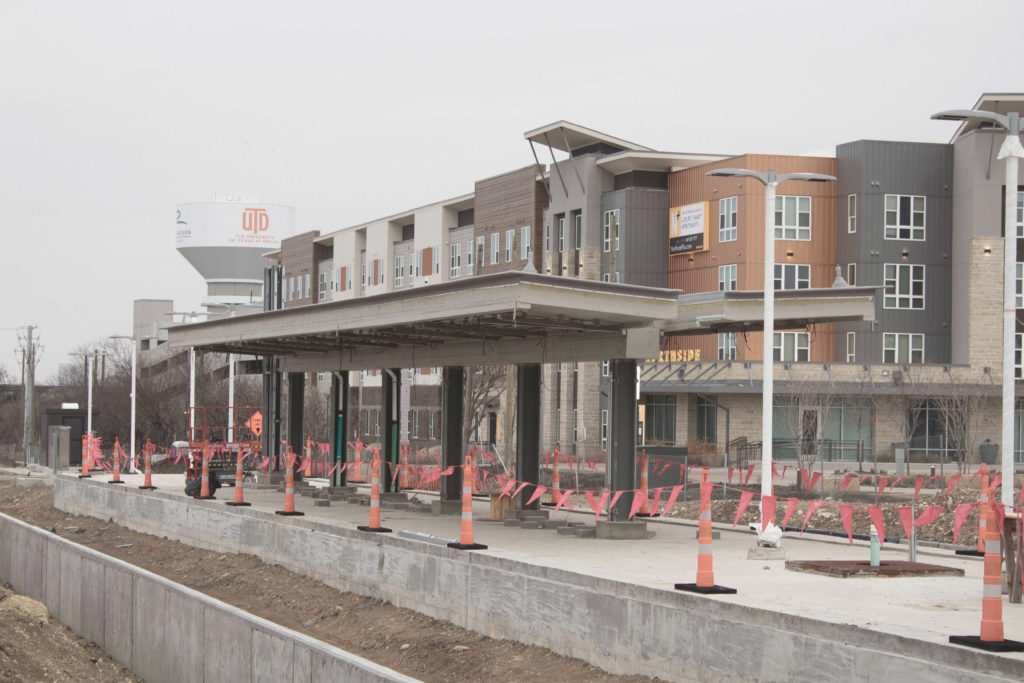In a partnership with Dallas Area Rapid Transit, or DART, and the city of Richardson, UTD is set to have one of the ten stations for DART’s Silver Line project just outside Northside. Estimated to start running 2026, the only college station in the project will facilitate travel for UTD students.
DART’s biggest capital project, the Silver Line project — originally known as the Cotton Belt Rail Line — is a 26-mile rail line planned to have 10 stations and travel through seven cities, connecting Shiloh Road in Plano to Terminal B of the DFW Airport in a 58-minute ride. According to John Hoppie, DART’s project manager in capital planning, the final design for the project is 95% complete. Hoppie said that each station is undergoing construction with personalized branding and amenities.
“We have an art and design program that has a budget for each station, and the personalization comes with the program,” Hoppie said. “[In] each station, for the most part, you have a platform, canopies, ticket vending machines [and] columns. The pictures of the UTD station show the art and design for that. It has the logo of the university and some images that are reflective of the university.”
Calvin Jamison, vice president for facilities and economic development, said that the station at Northside is estimated to be completed by July 2023, and branding for the station will be added later. The station is a part of a Transit Oriented Development, or TOD, plan and multimodal system, which incorporates amenities including a parking garage and charging stations.
“One of the major projects that we help design, build and develop is Northside, or as we affectionately call it, ‘Comet Town.’ The programmable spine is the area between Phases 1, 2 and 4,” Jamison said. “At the northern conclusion of the spine at Northside is where the Silver Line station is located. This is adjacent to an outdoor plaza that can be utilized by students, faculty and staff. There is shelter on the platform, while you wait on a respective train, and long-term there will also be several amenities, which will be an integral part of this TOD.”
Adhering to the Yield to Wheels program from the Federal Transit Administration, the DART light rail will include level boarding to accommodate wheelchairs, luggage and bicycles. Hoppie said that level boarding would make boarding safer and quicker as the train would spend less time at the station. In addition, the rail lines include features that prevent sun kinking — buckling of railroads at hot temperatures — and accommodate cold weather.
“The Silver Line is a new technology vehicle, at least new to DART,” Hoppie said. “So it’s a single vehicle, 276 feet long. They’re big, comfortable cars. There’s room for wheelchairs or bicycles or suitcases. There’s heaters and air conditioning on the trains so passengers will be comfortable. We’re implementing a very safe transit system, and it provides an alternative to the vehicle, the automobile, as well as other modes, so it may reduce the amount of traffic coming to and from campus if they’re taking the train.”
The proposed timings for the train are 6 a.m. to 9 p.m. on weekdays at 60-minute intervals and 30-minute intervals during peak hours. Working with Comets for Better Transit, Student Government senator Griffin Davis proposed a resolution suggesting that DART increase service time from 1 a.m. to 5 a.m. with a 30-minute frequency throughout the day, which has been passed by the Student Senate and proposed to DART’s Board of Directors.
“As a student, you’re not really just traveling during the morning and afternoon and evening, “ Griffin said. “You’re traveling anytime during the day, whenever you have classes. It’s really useful to have that 30-minute frequency all day long, even into the weekend, because waiting for an hour for a train makes it pretty difficult to use that train.”
UTD’s station will be accompanied by the Hike and Bike trail — also known as the Cotton Trail — which will provide first and last mile connections to the stations.
“The North Central Texas Council of Governments is working with each of the cities along the corridor to implement a hike and bike trail, and most of it is within our right of way for the Silver Line,” Hoppie said. “Most of it’s going to be constructed during the same time as the rail line. Some of it may be constructed a little bit afterwards, but it’ll help bring people to the station, so it’s got a lot of benefit.”
The $1.89 billion project is funded through public-private partnership via federal loans, transportation dollars and grants. In addition, Rep. Colin Allred secured the Consolidated Appropriations Act which granted DART $2.5 million to help build the UTD DART station.

“The $2.5 million will assist the university with our expanded sustainability efforts, particularly associated with [electric vehicle] stations and related sustainability projects,” Jamison said. “These are an integral part of the grant. The trains that DART will be utilizing are very quiet and environmentally friendly, supporting DART’s continued efforts to work with the university to advance sustainability. At the end of the day, UT Dallas is an absolute great place to advance sustainability, and around the Silver Line DART station, we will continue to partner with DART and the city of Richardson to support those efforts.”

Hoppie said he hopes to implement long-range mobility from Irving to Frisco in the future. While he has faced challenges coordinating the Silver Line project with all seven cities, he said that the project has been exciting and fun to work on.
“It was a fun project to work on… [with] a lot of challenges, but it’s unique in that we’re using a different vehicle than we’ve used in the past,” Hoppie said. “I worked on the Orange Line and that was only in Irving. It offered unique challenges, but it’s going to be a unique project. It could be the vehicle of the future.”


